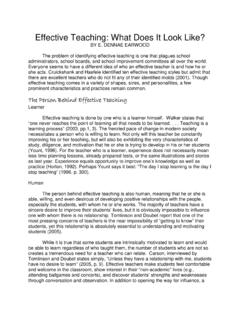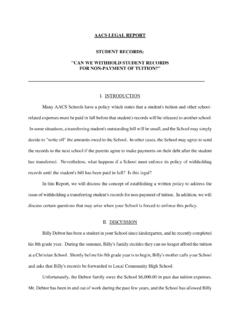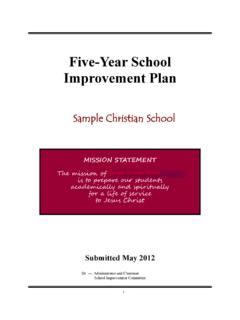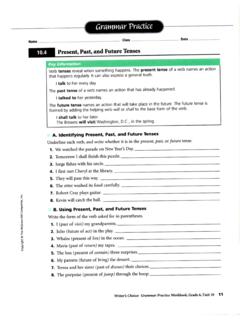Transcription of The Challenge of Selecting an Effective Curriculum
1 The Challenge of Selecting an Effective Curriculum By Beverly White A well-planned Curriculum can provide the academic foundation for an excellent education for Christian school students. Often, because the development of such a Curriculum can be time consuming and involved, it is not jointly pursued by the principal and teachers. Though perhaps there is no truly feasible way to lighten the burden of the Curriculum development process, the following article offers a methodical, structured approach for the selection and development of a Curriculum that will fit a Christian school s academic needs.
2 Three teachers walk slowly down the hall into the principal s office. The principal, Mr. Jasmine, greets the teachers and asks them to be seated. Mrs. Jones, the spokesperson of the committee of three, is the first to speak. Mr. Jasmine, could we talk to you a few minutes about our history Curriculum ? Why certainly, Mrs. Jones, Mr. Jasmine replies. I would be very interested in what you think about the history textbooks we are using. But in all honesty, I must admit that I know very little about history, especially in the elementary grades. Mrs. Jones continues with her remarks: We have been discussing our history Curriculum and what we hope to accomplish in our history classes.
3 To be honest with you, Mr. Jasmine, we are not happy with the textbooks we are presently using. Our Curriculum spends too much time on unimportant things. Besides that, the publisher s tests never seem to fit what we think should be tested. Mr. Jasmine leans forward, takes a note pad from his desk, and begins writing as Mrs. Jones continues her remarks. And the teachers edition isn t as much help as we would like it to be. But the worst thing, Mr. Jasmine, is our total history Curriculum ; as a whole it just doesn t meet the needs of our students. Our students study skills are weak; some students have difficulty reading the textbook; and, their essay answers are a disaster.
4 We are also concerned about the obvious gaps in the scope and sequence. Could we please change our Curriculum ? Does this sound familiar? Instead of history, perhaps it is math , or science, or English or Bible. It is a rare administrator who has not heard a cry for help from his teachers in relation to the Curriculum . It is discouraging when a faculty chooses a new textbook, loves it at first, and, within two years, is disenchanted - it is not any better than the last one. In fact, in some ways it is worse! What went wrong? Why was the enthusiasm short-lived? How can situations like the one described above be avoided?
5 What can be done to keep the Curriculum -changing cycle from occurring? How can a school choose a Curriculum that will meet its needs? There are no perfect curricula. Each has its own strengths and weaknesses. There are some factors and guidelines, however, that satisfy both the needs of the students and the expectations of the teaching staff. Four Factors To Consider First of all, what is a Curriculum ? A Curriculum is not a textbook; it is not a teacher s manual. A Curriculum is a complete teaching program. It includes textbooks, Curriculum guides, supplemental materials, goals and objectives, scope and sequence, and a variety of other materials.
6 Therefore, if a teacher is expecting a textbook to be a panacea for all the academic needs in the classroom, he is going to be disappointed. Second, the focus of a Curriculum is whatever a teaching staff wants it to be. For example, the physical education department can choose a Curriculum that focuses on team sports; or it can emphasize lifetime skills and habits. A science Curriculum can be textbook oriented; or it can emphasize experiments and the scientific method. The history Curriculum can focus on dates and events; or it can emphasize study skills, research, and higher-level thinking.
7 The English program can major on grammar exercises; or it can major on developing writing skills. The math department can focus on computation skills, or it can focus on word problems. If teachers want a Curriculum that focuses on one aspect of the subject and the administration chooses a program or textbook based on another, conflict will occur. Learning will be affected, and the real losers will be the students. The administration and the faculty must be in harmony. If the administration does not understand Curriculum , then the faculty should make the selection and explain their reasoning to the administration.
8 The focus of the Curriculum must be clearly identified and correctly implemented. Third, a Curriculum that works well at one school may not experience the same degree of success at another school. Schools have different teachers, different students, different communities, and different needs. This is why there are different textbook publishers who emphasize different content, different levels of learning, and different teacher methodology. Some of the greatest curricular disappointments happen when a school chooses a Curriculum just because another school recommends it. This is not to say that recommendations should not be welcomed or seriously considered when they are submitted.
9 Recommendations can provide valuable input into any selection process, but a Curriculum choice should not be based on recommendation alone. Only as staff members analyze their own unique situation can they determine the best Curriculum for their school. Fourth, Selecting a Curriculum involves more than choosing a textbook. The faculty should spend extensive time and effort in evaluating and Selecting a Curriculum . Smaller schools normally involve the entire department. For example, all the teachers teaching math in a school would be on the committee. Larger schools may designate a Curriculum committee of five to seven teachers to represent all the math teachers.
10 The administrator can head the project or serve in an approval capacity. Either way, the Curriculum committee will need to spend extra time (after school and during summer months) in the Curriculum selection process. It is recommended that teachers be allowed to use in-service time and, if possible, some school time. A school that wants a quality Curriculum must make a commitment toward that end. If the school is not committed, the end results of the Curriculum selection process will probably not include the desired outcomes. The selection process takes time, the effort of dedicated teachers, and a set of guidelines that controls the Curriculum adoption.






